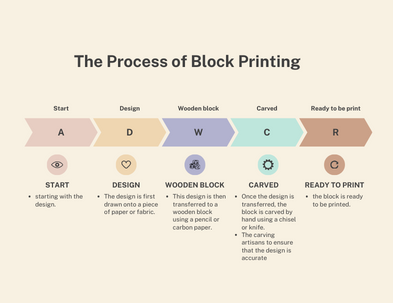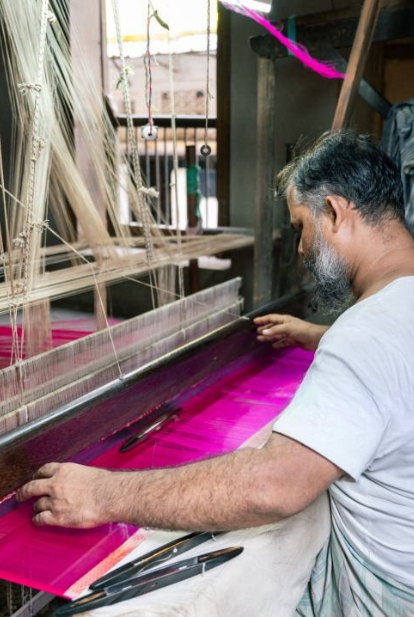The Art of Block Printing: Understanding the Process and Its Popularity
Block printing is more than a decorative technique — it's a celebration of craftsmanship, culture, and creativity. Rooted in Indian tradition and sustained by generations of skilled artisans, block printing is a beloved art form that continues to captivate the world.
What Is Block Printing?
Block printing is a centuries-old technique where wooden blocks are hand-carved with intricate patterns, dipped in dye, and pressed onto fabric to create beautiful designs. Originating in India, China, and Egypt, this method has stood the test of time for its elegance, efficiency, and eco-friendliness.
Block printing is more than just a method of creating patterns on fabric — it’s a centuries-old expression of identity, a celebration of handmade artistry, and a soulful tribute to heritage.
From the ancient lanes of Rajasthan and Gujarat to high-end global fashion houses today, this craft has journeyed through time, culture, and communities — one carved block at a time.
A Glimpse into the History of Block Printing
Block printing traces its roots to China around the 3rd century CE, but it found its most vibrant and enduring expression in India.
India’s legacy in block printing flourished with the rise of:
-
Sanganeri and Bagru printing in Rajasthan
-
Ajrakh printing in Gujarat and Sindh (now Pakistan)
-
Kalamkari block printing in Andhra Pradesh
By the 12th century, Indian block-printed textiles were exported to Southeast Asia, the Middle East, and Europe — admired for their rich colors, intricate floral motifs, and the unmistakable human touch.
During the Mughal era, block printing further evolved as artisans received royal patronage and developed sophisticated designs featuring Persian and Indian influences.
The Process of Block Printing (Step-by-Step)
1. Design Creation
The process begins with the creation of a design or motif. Traditionally, these designs are inspired by:
-
Nature (floral vines, birds, animals, trees)
-
Folklore and mythology (divine symbols, tribal patterns)
-
Geometry and symmetry (mandalas, borders, dots)
Designers sketch the patterns either freehand or digitally, ensuring repetition accuracy. The design is then split by color layers — because each color will require its own block later.
This is the soul of the print — the visual language that speaks through every motif.
2. Block Carving
Once the design is finalized, it’s handed over to master block carvers who work with:
-
Teakwood or Sheesham wood – strong, durable, and long-lasting.
The process involves:
-
Transferring the design onto the wooden block.
-
Carving negative spaces (areas not to be printed), using chisels, hammers, and fine blades.
-
Ensuring deep and clean cuts so that dye spreads evenly.
Each block is polished and soaked in oil before use. For a design with three colors, three separate blocks are carved — one for each color layer.
The precision of the block defines the clarity of the print.
3. Preparing the Fabric
Natural fabrics — like cotton, silk, linen, or blends — are used as they absorb color well. Before printing, the fabric goes through:
-
Scouring (washing with mild soap) to remove starch, oil, or dust
-
Bleaching or mordanting (depending on the dye used)
-
Stretching on long tables to remove wrinkles and secure the fabric for printing
A clean, taut fabric ensures uniform dye absorption and neat impressions.
4. Dyeing the Blocks
Artisans prepare dyes — either natural dyes (from pomegranate, indigo, turmeric, etc.) or AZO-free low-impact dyes.
The dye is poured onto a soft sponge pad or tray, and the block is:
-
Dipped onto the dye pad lightly
-
Ensured it holds just the right amount of dye to avoid bleeding
The tray must be refilled and cleaned often to maintain consistency in color density.
This is where sustainability meets style — beautiful, safe, and chemical-light.
5. Printing by Hand
The artisan places the dye-loaded block onto the fabric with:
-
Steady pressure
-
Precise alignment using guide marks
-
Firm tapping on the back of the block to transfer the dye
This step is repeated for each block and each color, layered carefully to maintain the integrity of the pattern. Depending on the fabric length, hundreds of impressions might be required — all by hand.
No machines. No automation. Just rhythm, skill, and unmatched human touch.
6. Drying & Fixing
Once printed, the fabric is left to:
-
Air dry in shade or sunlight
-
Sometimes steamed or heat-set, depending on the dye
-
Washed gently to remove excess dye and bring out the final color richness
The fabric is finally ironed, folded, and sent for stitching or sale.
This step ensures the colors last and retain their beauty for years.
No machines. No shortcuts. Just hands, heritage, and heart.
Why Is Block Printing So Popular?
✔️ Eco-Friendly Fashion
Block printing uses handmade processes, natural dyes, and biodegradable materials, making it a sustainable choice.
✔️ Timeless Beauty
Each item has its own character — no two pieces are ever exactly alike.
✔️ Cultural Value
Block-printed textiles carry India’s regional identity — like Bagru, Sanganeri, or Ajrakh patterns.
✔️ Global Revival
Designers worldwide are turning to block prints for slow fashion, home décor, and wearable art — from saris to cushion covers.
How to Incorporate Block Prints in Your Life
| Product | How to Use |
|---|---|
| Sarees & Dupattas | Drape culture with grace |
| Table Runners | Add charm to your dining setting |
| Curtains & Cushions | Soften your interiors with ethnic flair |
| Tote Bags & Scarves | Everyday elegance with a story |
Weavehand & Block Printing
At Weavehand, we work directly with artisans who specialize in block printing. Each piece we offer — whether it's a table runner or a festive dupatta — is infused with craft, care, and cultural pride.
When you buy block-printed fabric, you don’t just wear art — you support a village.
Final Thoughts
Block printing reminds us of a slower, more intentional way of creating beauty. It connects us to the land, to tradition, and to each other.
So next time you shop for textiles, choose block prints — not just for their looks, but for their legacy.




